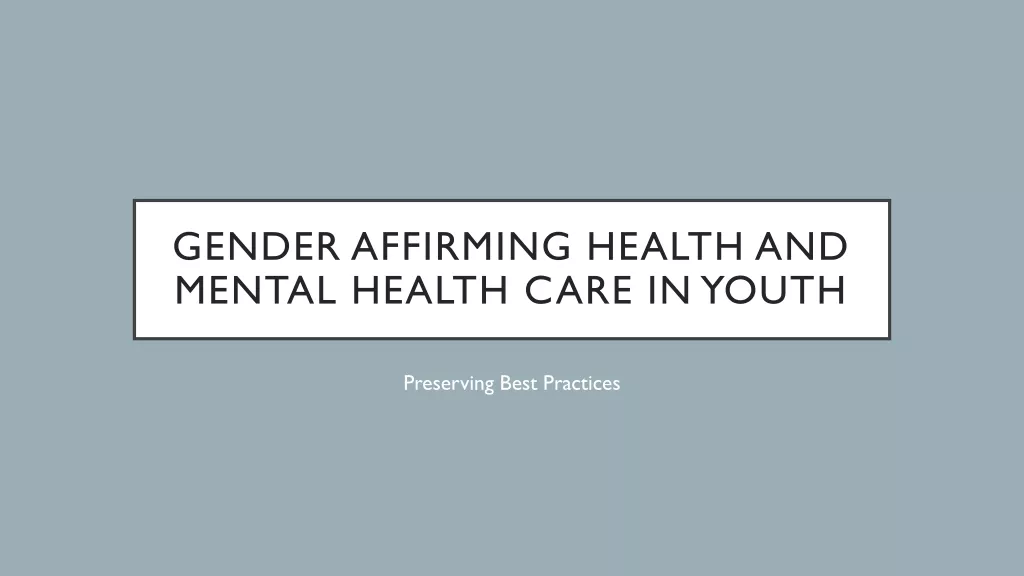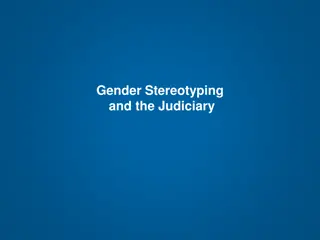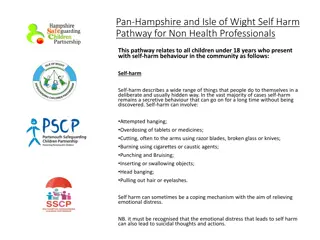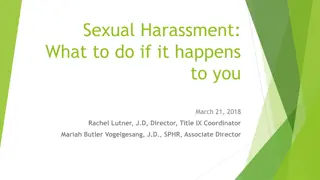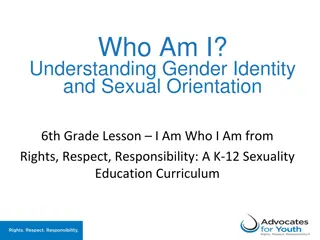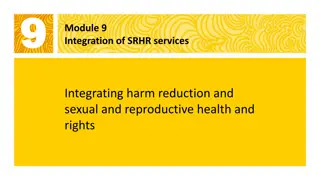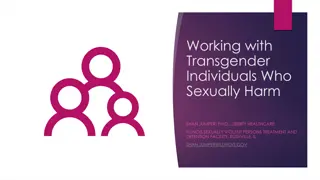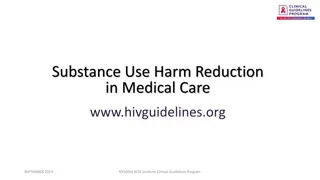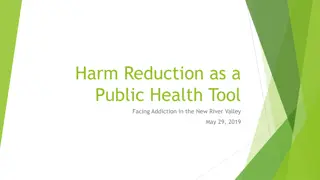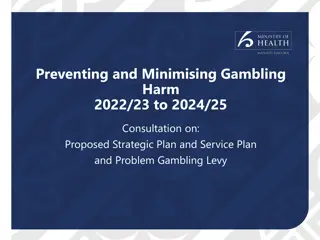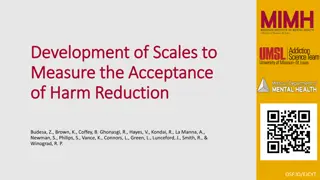Understanding Gender, Sexual Health, and Harm Reduction
Explore the intersection of gender norms, sexual and reproductive health, and harm reduction in Module 1. Learn about the impacts of gender inequality, stereotypes, and the importance of integrating SRHR services into harm reduction programs. Engage in activities to challenge traditional gender roles and deepen your understanding of societal norms.
Download Presentation

Please find below an Image/Link to download the presentation.
The content on the website is provided AS IS for your information and personal use only. It may not be sold, licensed, or shared on other websites without obtaining consent from the author. Download presentation by click this link. If you encounter any issues during the download, it is possible that the publisher has removed the file from their server.
E N D
Presentation Transcript
1 1 Module 1 Gender, sexual and reproductive health and rights and harm reduction Integrating harm reduction and sexual and reproductive health
Module 1 Gender, sexual and reproductive health and rights and harm reduction LEARNING OBJECTIVES 2 hours and 15 mins To understand the harms of gender norms and gender inequality To understand the compound effects of stereotyping for women and gender non-conforming people who use drugs To understand sexual and reproductive health and rights (SRHR) and the importance of the continuum of care for SRHR services To list the advantages and challenges of integrating SRHR services in harm reduction programmes
Module 1 Gender, sexual and reproductive health and rights and harm reduction PORTRAITS: 10 mins Working in 2 groups Use the cards to draw the portrait of the good man and the portrait of the good woman
Module 1 Gender, sexual and reproductive health and rights and harm reduction PORTRAITS GAME OF THE ROLES OF WOMEN AND MEN: 15 mins Individually Who has the role for ? Move in front of the flipchart with the portrait of the good man or the good woman, according to the role described.
Module 1 Gender, sexual and reproductive health and rights and harm reduction KEY DEFINITIONS
Module 1 Gender, sexual and reproductive health and rights and harm reduction GENDER NORMS Gender norms tend to assign women roles, usually associated with the private sphere, and men roles, usually associated with the public sphere. For example: Men are decision-makers Men are masculine in appearance and action Women are homemakers Women are feminine in appearance and actions These gender roles do not occur due to natural differences between the sexes. Rather they are constructed, and come to seem natural because they are deeply embedded in our societies, through things such as culture and religion. These norms vary from place to place and can change over time. They have a very powerful influence on us in many different ways
Module 1 Gender, sexual and reproductive health and rights and harm reduction GENDER STEREOTYPES Is a generalised view or preconception about the physical (including biological, emotional and cognitive) attributes or characteristics that are or should be possessed by women and men. Transgender people and gender non-conforming people also experience harm from gender stereotypes, including serious discrimination that leads to social and economic marginalisation. Gender norms and stereotypes have a profound affect on every aspect of life (such as our economic lives, our SRHR, our representation in decision- making, our domestic and community care roles).
Module 1 Gender, sexual and reproductive health and rights and harm reduction CASE STUDIES: 20 mins What are the types of norms and stereotypes faced by the woman who uses drugs in the case study? Who expresses these norms or stereotypes (e.g. family members, community, health professionals)? What are the specific harms and consequences of these gender stereotypes? DISCUSSION: Do you think you also hold your own stereotypes about women and gender non-conforming people who use drugs, or other marginalised women like sex workers, women living with HIV and transgender women? Do you think these views might impact the range of services you provide and the way you provide them?
Module 1 Gender, sexual and reproductive health and rights and harm reduction HARMS OF GENDER NORMS AND STREOTYPES Gender stereotyping is a pervasive human rights violation Harms of gender stereotypes : Overburdening Stigma Discrimination Low self-esteem and lack of confidence Fear to access support Violence (physical, emotional and sexual violence) Lose child custody Harmful gender norms and stereotypes are a root cause of gender-based violence and a rights violation
Module 1 Gender, sexual and reproductive health and rights and harm reduction GENDER EQUALITY Gender equality means that men and women are sharing the same opportunities for full realisation of their human rights. Gender inequality and gender-stereotyping prevent women and gender non-conforming people to access sexual and reproductive health services. In particular, women and gender non-conforming people who use drug face compounded stigma, which is when multiple layers of stigma (e.g. based on gender, race/ethnicity, age, and other factors) overlap. For example, both women and men who use drugs may face stigma, but women who use drugs are often doubly stigmatised because drug use is seen as going against strongly held norms and expectations about being a woman such as childcare and modest behaviour. Women and gender non-conforming people who use drugs are at high risk of violence based on social stereotypes, backed by punitive laws.
Module 1 Gender, sexual and reproductive health and rights and harm reduction
Module 1 Gender, sexual and reproductive health and rights and harm reduction
Module 1 Gender, sexual and reproductive health and rights and harm reduction CROSS THE LINE EXERCISE: 15 mins Move and cross the line on the left side if you agree, on the right side if you don t agree
Module 1 Gender, sexual and reproductive health and rights and harm reduction SEXUAL AND REPRODUCTIVE RIGHTS Sexual and reproductive rights are human rights that apply to sexual and reproductive health. Sexual rights can include: The ability to seek, receive and give information about sexuality The right to be free from violence, pressure or coercion from a partner, and to practice safer sex The right to say no and the right to a consensual marriage (above the legal age) and/or partnership. The choice of sexual partner(s). The right to decide to be sexually active or not The right to pursue a satisfying, safe and pleasurable sex life Freedom to discover and develop one s sexuality Freedom from harmful practices, like genital mutilation and bride price
Module 1 Gender, sexual and reproductive health and rights and harm reduction SEXUAL AND REPRODUCTIVE RIGHTS Reproductive rights are the rights of people to decide whether to give birth to a child or not, without discrimination, coercion or violence. They allow women to control their own reproduction. Reproductive rights can include: The choice to have children, and the freedom to decide if, when, and how many. The right to correct information, choices and services related to reproductive health, including family planning, pregnancy and maternal care. Freedom from forced sterilisation.
Module 1 Gender, sexual and reproductive health and rights and harm reduction SEXUAL AND REPRODUCTIVE RIGHTS Reproductive rights are the rights of people to decide whether to give birth to a child or not, without discrimination, coercion or violence. They allow women to control their own reproduction. Reproductive rights can include: The choice to have children, and the freedom to decide if, when, and how many. The right to correct information, choices and services related to reproductive health, including family planning, pregnancy and maternal care. Freedom from forced sterilisation.
Module 1 Gender, sexual and reproductive health and rights and harm reduction CONTINUUM OF CARE: 15 mins Working in 3 groups Pick and choose one sticky note Discuss if this specific service is available only through SRH services facility or harm reduction programmes, or already integrated Stick the note in the circle
Module 1 Gender, sexual and reproductive health and rights and harm reduction GROUP EXERCISE: 15 mins Working in 2 groups List the advantages and disadvantages of linking and integrating SRHR services into harm reduction programmes REPORT BACK: 5 mins
Module 1 Gender, sexual and reproductive health and rights and harm reduction THE CONTINUUM OF CARE It covers all the stages of human life (children/adolescent/adult/elder) Ensures a continuum of adapted services at all stages of life Ensures a continuum of adapted services in terms of accessibility (from services delivered at the community level, in primary health centers, at hospital). Should be established to ensure links between SRHR and HIV prevention, care and treatment with all other harm reduction services. * A continuum is something that is made up of a collection of stages or elements
Module 1 Gender, sexual and reproductive health and rights and harm reduction
Module 1 Gender, sexual and reproductive health and rights and harm reduction Challenges It can be perceived to overburden services and facilities It can be a drain on already-limited resources if not carefully planned Advantages Improve access and increase uptake Provide better care Reduce stigma Increase efficiency



